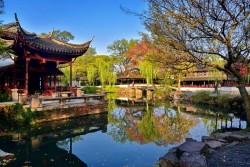You have no items in your shopping cart.


Introducing Panmen Gate
The Panmen Gate is also known as Pan Gate. The Panmen Gate is a historical landmark in Suzhou. The Panmen Gate, originally constructed during the Spring and Autumn period in the state of Wu, boasts an impressive age of approximately 2,500 years. Panmen Gate comprises both a land city gate and a water city gate. This innovative architectural approach allowed for efficient water control and robust defense against potential aggressors.
The existing Panmen Gate Tower was erected in 1986, commemorating Suzhou’s 2,500-year history. Stretching across 300 meters (approximately 328 yards), the city wall stands at a height of 16 feet (5 meters). Walking along the northern slope of the wall provides a breathtaking panoramic view of Panmen City Gate. The Panmen Scenic Area, centered around Panmen Gate, beckons visitors with additional attractions. Notably, the Ruiguang Pagoda, Suzhou’s oldest pagoda, and the Wumen Bridge, an ancient bridge with historical significance, await exploration within this captivating locale.
Panmen Gate Fast Facts
• AKA: Panmen Scenic Area
• Chinese Name: Panmen 盘门
• Best Time to Visit: April to October
• Recommended Visiting Hours: 2 - 3 x hours
• Things to Do: Photography, Architecture, History and Culture
• Opening Hours: 8:30 – 21:00
• Entrance Fee: CNY36
• Address: No. 49 East Street, Gusu District, Suzhou, Jiangsu Province
What to Expect at Panmen Gate
How to Get to Panmen Gate
• By Bus: Take bus 317 to Panmen Jingqubei Station.
• By Subway: Take subway line 4 to Nanmen Station.
Additional Travel Advice on Panmen Gate
• Tourist Center is at the east entrance of the scenic area, offering multiple services: Information Inquiry, Baby stroller/Phone charger/Wheelchair lending, etc.
• The entrance ticket includes boating (about 10 minutes) for sightseeing.